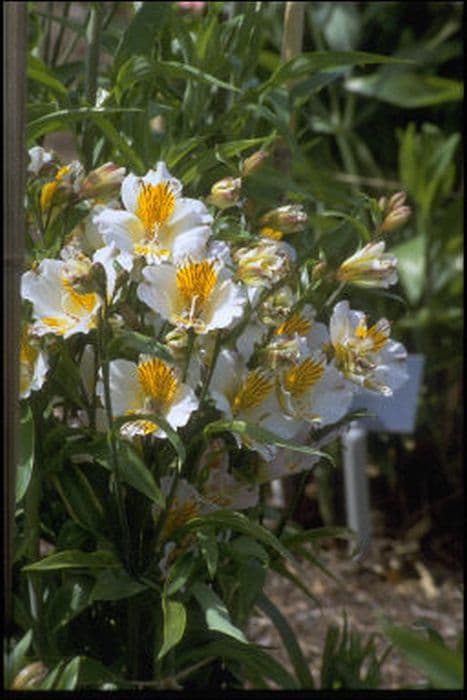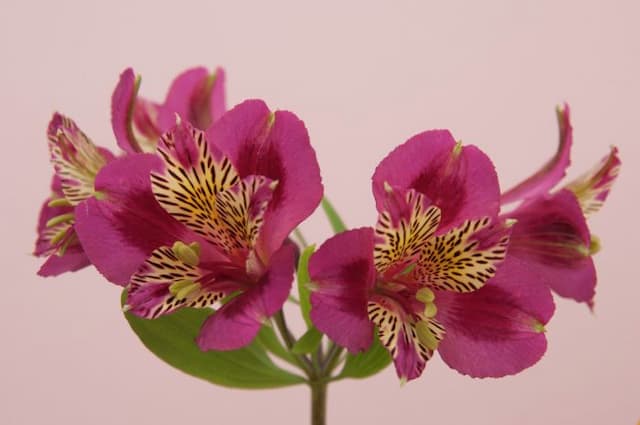Peruvian Lily Alstroemeria 'Tara' (PBR) (Little Miss Series)

ABOUT
Alstroemeria 'Tara' (PBR) from the Little Miss Series is a striking ornamental plant commonly known as Peruvian Lily or Lily of the Incas. It is cherished for its vibrant floral display and longevity as a cut flower. The plant bears a profusion of eye-catching blooms which are characterized by their trumpet-like shape and a blend of two or more colors. Each petal of the Peruvian Lily typically exhibits a mix of hues, with a common color combination being golden yellow petals that are flushed with streaks or flecks of deep burgundy or brown markings. The flowers have six slightly curved petals that create a symmetrical star shape, adding an exotic flair to the overall appearance. The leaves of Peruvian Lily 'Tara' are narrow and elongated, taking on a lanceolate form. They are usually glossy green, creating a lush backdrop that contrasts beautifully with the bright flowers. The foliage can often appear twisted or spiraled, giving the plant an interesting texture. Additionally, the stems of the Alstroemeria 'Tara' are sturdy, supporting the weight of the blooms and allowing them to stand out in the garden setting. Overall, its dazzling floral display with striking colors and patterns, complemented by lush green foliage, makes the Alstroemeria 'Tara' a favorite among garden enthusiasts and floral arrangers alike. Please note that specific sizes and dimensions cannot be provided in this description.
About this plant
 Names
NamesFamily
Alstroemeriaceae
Synonyms
Peruvian Lily, Lily of the Incas
Common names
Alstroemeria 'Tara' (PBR) (Little Miss Series)
 Toxicity
ToxicityTo humans
The Peruvian Lily is generally not considered highly toxic to humans. However, handling the plant may cause skin irritation or an allergic reaction in some individuals due to the presence of tulipalin, a compound found in the plant. If ingested, it may cause mild gastrointestinal discomfort, including nausea, vomiting, or diarrhea. It is not commonly known as a hazardous plant for humans to consume, but it's still advisable to avoid ingestion and to handle with care if one has sensitive skin.
To pets
The Peruvian Lily can be toxic to pets if ingested. Symptoms of poisoning in pets, particularly cats and dogs, may include vomiting, diarrhea, and drooling. In rarer cases, it can also cause dermatitis. It is advisable to keep the Peruvian Lily out of reach of pets to avoid the risk of ingestion and potential health issues.
 Characteristics
CharacteristicsLife cycle
Perennials
Foliage type
Evergreen
Color of leaves
Green
Flower color
Mixed
Height
1 foot 2 inches (35 cm)
Spread
1 foot 2 inches (35 cm)
Plant type
Bulb
Hardiness zones
7
Native area
South America
Benefits
 General Benefits
General Benefits- Long Blooming Season: Produces flowers for an extended period, typically from late spring through fall.
- Attractive Flowers: Showcases eye-catching, trumpet-shaped blooms in vibrant colors, adding aesthetic appeal to gardens and landscapes.
- Drought Tolerant: Once established, it requires less water compared to many other perennials, suiting water-wise gardens.
- Cut Flower: The blooms are long-lasting in arrangements, making it an excellent choice for cut flower enthusiasts.
- Compact Size: Part of the Little Miss Series, it is bred to be more compact, suitable for small gardens and container planting.
- Easy to Grow: This variety is known to be resilient and easy to care for, tolerating a range of soil types and conditions.
- Attracts Pollinators: Invites bees, butterflies, and other pollinating insects to the garden, supporting biodiversity.
- Hybrid Vigor: As a hybrid, it is generally vigorous and robust, often with better disease resistance and performance.
- Longevity: These perennials can live for several years, making them a lasting addition to the garden.
- Low Maintenance: Requires minimal upkeep beyond regular watering and occasional fertilization.
 Medical Properties
Medical PropertiesThis plant is not used for medical purposes.
 Air-purifying Qualities
Air-purifying QualitiesThis plant is not specifically known for air purifying qualities.
 Other Uses
Other Uses- Alstroemeria, also known as Peruvian lily, can be used as a natural dye; the flowers provide colors ranging from yellows to reds, which can be used to dye fabrics or paper.
- The sturdy stems of Peruvian lilies make them ideal as supports for lighter or weaker-stemmed flowers in mixed bouquets.
- Dried Peruvian lily petals can be incorporated into homemade potpourri mixes for a colorful and potentially fragrant addition.
- Pressed Peruvian lily flowers can be used for decorative purposes, such as creating bookmarks, greeting cards, or even framed botanical art.
- The blooms of Peruvian lilies can be floated in large shallow dishes or bowls as a decorative centerpiece for events or just to add a touch of elegance to a room.
- Scented sachets filled with dried Peruvian lily petals can be placed in drawers or closets to impart a delicate fragrance to linens and clothing.
- In some cultures, Peruvian lilies may be used as a symbol in festivals or ceremonies, representing friendship and devotion, which are meanings often associated with the flower.
- Florography, or the language of flowers, often includes Peruvian lilies, and they can be used in floral messages to convey complex emotions like the twists and turns of friendship.
- The petals of Peruvian lilies can be used in art projects for children, such as making collages or decorating picture frames due to their vibrant and varied colors.
- Peruvian lily plants can be used as a study subject in botany or horticulture programs due to their interesting breeding, hybridization characteristics, and their ability to adapt to different environmental conditions.
Interesting Facts
 Feng Shui
Feng ShuiThe Peruvian Lily is not used in Feng Shui practice.
 Zodiac Sign Compitability
Zodiac Sign CompitabilityThe Peruvian Lily is not used in astrology practice.
 Plant Symbolism
Plant Symbolism- Friendship: Alstroemerias, commonly known as Peruvian Lilies or Lily of the Incas, often symbolize strong and lasting friendships, due to their long-lasting nature.
- Devotion: The twists in the petals of the Peruvian Lily are said to represent the trials and tribulations of true and devoted friendship.
- Wealth: With their multitude of blooms on each stem, Peruvian Lilies can signify prosperity and wealth.
- Achievement: The bright and vibrant colors of the Peruvian Lily 'Tara' embody success and the achievement of personal aspirations.
- Fortune: Because of their abundant and multi-flower stems, Peruvian Lilies are also associated with good luck and the bounties of life.
 Water
WaterPeruvian lily should be watered regularly to keep the soil moist but not soggy. During the growing season, water the plant thoroughly once the top inch of soil feels dry to the touch, which might be approximately once a week. In hotter weeks, you may need to water more frequently to prevent the soil from drying out too quickly. Provide about one to two gallons of water each time, ensuring even distribution around the plant to encourage deep root growth. Reduce watering during the dormant winter months, and only water lightly to prevent the soil from completely drying out.
 Light
LightPeruvian lily thrives best in full sun to partial shade conditions. The ideal spot for this plant would be an area that receives at least six hours of direct sunlight each day, but can also benefit from some afternoon shade during the hottest parts of the day to protect the foliage from scorching, especially in very warm climates.
 Temperature
TemperatureThe Peruvian lily can tolerate a wide range of temperatures but grows best when the temperature is between 65 and 80 degrees Fahrenheit. It can survive minimum temperatures down to about 25 degrees Fahrenheit, but it's important to protect it from frost to prevent damage. Maximum temperatures should not exceed 90 degrees Fahrenheit, as excessive heat can stress the plant.
 Pruning
PruningPeruvian lily should be pruned to remove spent flowers and encourage new growth. This can be done as often as flowers fade, generally every few weeks during the blooming season. The best time for pruning is after the first flush of flowers are spent, and again at the end of the blooming season to tidy up the plant. Deadheading spent blooms can also encourage a second wave of blooming.
 Cleaning
CleaningAs needed
 Soil
SoilPeruvian Lily 'Tara' thrives best in rich, well-draining soil with a pH between 6.0 and 7.0. Create a soil mix using two parts peat or coco coir, one part perlite or vermiculite, and one part compost to ensure fertility and good drainage.
 Repotting
RepottingThe Peruvian Lily 'Tara' should be repotted every two to three years or when the plant becomes root-bound. This timing helps ensure the health of the plant by providing fresh nutrients and space for continued root growth.
 Humidity & Misting
Humidity & MistingPeruvian Lily 'Tara' prefers moderate humidity levels but is quite adaptable. Aim for humidity levels between 40% to 60% for optimal growth without the need to create a high-humidity environment.
 Suitable locations
Suitable locationsIndoor
For Peruvian Lily 'Tara', provide bright indirect light and keep soil moist.
Outdoor
Plant Peruvian Lily 'Tara' in well-draining soil and full to partial sun.
Hardiness zone
7-10 USDA
 Life cycle
Life cycleAlstroemeria 'Tara', also known as Peruvian Lily 'Tara', starts life as a tuberous rhizome, which, under suitable conditions of warmth and light, begins to sprout foliage and establishes a rosette of leaves. As the plant matures, stems elongate, and lance-shaped leaves develop along them. The onset of flowering typically occurs in late spring or early summer, when the plant produces its distinctive funnel-shaped flowers with streaked and speckled petals in hues of yellow, orange, or red. After pollination, which is usually aided by insects, the flowers develop into capsule-like fruits containing several seeds. Following seed dispersal, the plant may enter a period of dormancy, particularly if it is grown in regions with cooler winters. Throughout the growing season, the Peruvian Lily 'Tara' also propagates vegetatively by producing new offsets from its rhizomes.
 Propogation
PropogationPropogation time
Spring-Early Summer
The Alstroemeria 'Tara', a member of the Little Miss Series, is often propagated by division, which is the most popular method for this plant. Division should ideally be done in the spring as the plants emerge from dormancy. To propagate by division, you should carefully lift the clump of tubers from the ground using a spade. Once out of the soil, gently separate the tubers, making sure each division has at least one growth point or eye. These divisions can be immediately replanted in well-draining soil, spaced about 12 to 18 inches (30 to 45 centimeters) apart to allow enough room for growth. It's important to water the new plantings thoroughly to help establish the roots in their new location. Division not only helps to propagate new plants but also to rejuvenate older clumps that may have become too dense.





![Peruvian lily [H.R.H. Princess Alice]](/_next/image?url=https%3A%2F%2Fplants-admin.emdemapps.com%2Fimages%2Fplants%2F%2Fimages%2F604b55e81c8b0.png&w=640&q=75)

![Peruvian lily [Inca Coral]](/_next/image?url=https%3A%2F%2Fplants-admin.emdemapps.com%2Fimages%2Fplants%2F%2Fimages%2F604b5b79b85ce.png&w=640&q=75)
![Peruvian lily [Inca Exotica]](/_next/image?url=https%3A%2F%2Fplants-admin.emdemapps.com%2Fimages%2Fplants%2F%2Fimages%2F604b5ec0e34a9.png&w=640&q=75)
![Peruvian lily [Inca Milk]](/_next/image?url=https%3A%2F%2Fplants-admin.emdemapps.com%2Fimages%2Fplants%2F%2Fimages%2F604b5f14b0b6a.png&w=640&q=75)